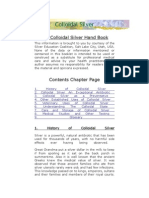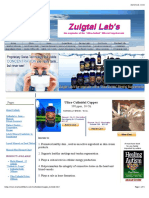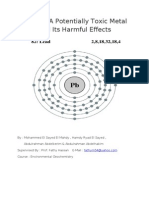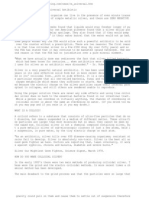History of This Metals
History of This Metals
Uploaded by
daniel romanoCopyright:
Available Formats
History of This Metals
History of This Metals
Uploaded by
daniel romanoOriginal Title
Copyright
Available Formats
Share this document
Did you find this document useful?
Is this content inappropriate?
Copyright:
Available Formats
History of This Metals
History of This Metals
Uploaded by
daniel romanoCopyright:
Available Formats
History of this metals:
Copper:Copper was first used by the Sumerians and the Chaldeans living in ancient
Mesopotamia are believed to be the first people to make wide use of copper, and
their copper crafting knowledge was introduced to the ancient Egyptians.
Lead:The Ancient Egyptians were likely the first to extract lead, which they used to
make small sculptures. But In China, lead was used to forge coins by 2000 BC.
Zinc:Zinc was first discovered by the Romans but the German chemist Andreas
Marggraf in the year 1746 was the one to be the first to recognise it as a new metal
in all Europe.
Cooper:
When was copper discovered?
Copper was first used between 8,000 and 5,000 B.C., mostly likely in the regions
known now as Turkey, Iran, Iraq and — toward the end of that period — the Indian
subcontinent.
Where can we find Copper?
Copper is found in highest amounts in protein foods like organ meats, shellfish, fish,
nuts, and seeds as well as whole grains and chocolate.Dark leafy greens, dried fruits
such as prunes, cocoa, black pepper, and yeast are also sources of copper in the
diet.
What is copper used for?
The primary applications of copper are in electrical wiring, roofing, plumbing, and
industrial machinery. For most of these applications, copper is used in its pure
form.Of course Copper is mostly used in electricity since it is a great conductor of
electricity.
Is copper dangerous for our health?
Yes, copper can be harmful if you get too much. Getting too much copper on a
regular basis can cause liver damage, abdominal pain, cramps, nausea, diarrhea,
and vomiting.Copper toxicity is rare in healthy individuals. But it can occur in people
with Wilson's disease, a rare genetic disorder.
Lead:
When was Lead discovered?
Lead was discovered in the Bronze or Iron Ages,in the year 6,400 BC from the
Neolithic settlement Çatalhöyük (situated in the central part of modern day Turkey).
Where can we find Lead?
Paint,Dust,Soil,Drinking water,Air,Folk medicines, ayurvedics, and
cosmetics,Children's jewelry and toys,Workplace and hobbies,Consumer
Products.Lead can be found in candy, wrappers, pottery containers, and in certain
ethnic foods, such as chapulines (dried grasshoppers).
What is Lead used for?
Lead has been used in a wide variety of products found in and around our homes,
including paint, ceramics, pipes and plumbing materials, soldiers, gasoline, batteries,
ammunition and cosmetics.
Is Lead dangerous for our health?
Yes,Young children are particularly vulnerable to the toxic effects of lead and can
suffer profound and permanent adverse health impacts, particularly on the
development of the brain and nervous system. Lead also causes long-term harm in
adults, including increased risk of high blood pressure and kidney damage.Even
blood lead concentrations as low as 3.5 µg/dL may be associated with decreased
intelligence in children, behavioral difficulties and learning problems. As lead
exposure increases, the range and severity of symptoms and effects also increase.
Zinc:
When was Zinc discovered?
Zinc was discovered in 1746 in Germany,but the principal mining areas are in China,
Australia and Peru.
Where can we find Zinc?
Zinc can be found in oysters, but it's also plentiful in red meat and poultry. Other
good sources are beans, nuts, crab, lobster, whole grains, breakfast cereals, and
dairy products.The following foods are good sources of zinc.Oysters contains more
zinc per serving than any other food, but beef contributes 20% of zinc intakes from
food in the United States because it is commonly consumed,Eggs and dairy products
also contain zinc.
What is Zinc used for?
It is a major used in medicine and science in the creation of DNA, growth of cells,
building proteins, healing damaged tissue, and supporting a healthy immune
system.Its also used when you have a really bad fracture they put zinc in your bones
so it can be cured faster.
Is Zinc dangerous for our health?
Yes, too much zinc can be harmful,too much zinc includes nausea, dizziness,
headaches, upset stomach, vomiting, and loss of appetite. Also If you take too much
zinc for a long time, you could have problems such as lower immunity, low levels of
HDL ("good") cholesterol, and low copper levels in your body.Zinc is also likely safe
when used in amounts no greater than 40 mg daily.It is possibly safe when taken in
larger doses, especially when used only for a short period of time. But taking doses
higher than 40 mg daily might decrease how much copper the body absorbs.
You might also like
- Colloidal Silver BookDocument24 pagesColloidal Silver Bookusccc11100% (2)
- Dr. Joel WallachDocument10 pagesDr. Joel WallachfabriciopNo ratings yet
- Hooper David - The Colloidal Silver Hand BookDocument23 pagesHooper David - The Colloidal Silver Hand BookStarla ShermanNo ratings yet
- The MSM MiracleDocument48 pagesThe MSM Miraclesirrichard1100% (3)
- Colloidal Silver Brochure PDFDocument11 pagesColloidal Silver Brochure PDFnino c.r.No ratings yet
- The Handbook of Colloidal SilverDocument20 pagesThe Handbook of Colloidal Silveracuario33100% (9)
- Richmond - Grammar Practice in Context - With - Key PDFDocument217 pagesRichmond - Grammar Practice in Context - With - Key PDFCote SalasNo ratings yet
- The Colloidal Silver Generator: by Truman Berst, Master HerbalistDocument10 pagesThe Colloidal Silver Generator: by Truman Berst, Master HerbalistMarvin T Verna100% (1)
- Notes From Dead Doctors Dont LieDocument4 pagesNotes From Dead Doctors Dont Liekatyayanianshu100% (14)
- TEXAS Body Paragraph Writing With SourceDocument3 pagesTEXAS Body Paragraph Writing With SourceGulrukh Sadullayeva100% (2)
- Small Bakery Business ProposalDocument2 pagesSmall Bakery Business Proposalvadavada100% (4)
- The Other Trace ElementsDocument12 pagesThe Other Trace ElementsperlatomsNo ratings yet
- Food Sources of Essential Minerals and Trace Elements: CalciumDocument4 pagesFood Sources of Essential Minerals and Trace Elements: CalciumstalNo ratings yet
- Uses of ElementsDocument43 pagesUses of ElementsApril Rose DeoronioNo ratings yet
- Dr. Joel WallachDocument10 pagesDr. Joel WallachfabriciopNo ratings yet
- Chapter IDocument10 pagesChapter IRPONTEJONo ratings yet
- Our Toxic Legacy: How Lead, Mercury, Arsenic, and Cadmium Harm Our HealthFrom EverandOur Toxic Legacy: How Lead, Mercury, Arsenic, and Cadmium Harm Our HealthNo ratings yet
- Health Benefits of Traditional UtensilsDocument13 pagesHealth Benefits of Traditional UtensilsTheGreyHavensNo ratings yet
- Colloidal Silver - Jamaicans Are Clamouring For This Miracle' Drink!Document2 pagesColloidal Silver - Jamaicans Are Clamouring For This Miracle' Drink!DA10000No ratings yet
- Calcium ScriptDocument1 pageCalcium ScriptzaaraNo ratings yet
- Copper ConsumerDocument3 pagesCopper ConsumerVinay SekharNo ratings yet
- Topic: Minerals Mineral: Copper: Team Members Fatima Shoaib Asra Iftikhar Ilsa Khan Shazyl Khalid Jawad GhulamDocument24 pagesTopic: Minerals Mineral: Copper: Team Members Fatima Shoaib Asra Iftikhar Ilsa Khan Shazyl Khalid Jawad GhulamAbid hussainNo ratings yet
- How To Reduce Your Exposure To Harmful Heavy Metals and Detoxify Your Body - Center For Advanced Medicine & Clinical ResearchDocument15 pagesHow To Reduce Your Exposure To Harmful Heavy Metals and Detoxify Your Body - Center For Advanced Medicine & Clinical ResearchmhabranNo ratings yet
- Colloidal CopperDocument6 pagesColloidal CopperRueth AnnafeyeNo ratings yet
- Barley Facts: Can Prevent and Heal AilmentsDocument4 pagesBarley Facts: Can Prevent and Heal Ailmentscaijoy7769No ratings yet
- Collidial Silver EbookDocument15 pagesCollidial Silver Ebookliaya76No ratings yet
- Copper - An Important MetalDocument5 pagesCopper - An Important Metalsneha wazNo ratings yet
- Organic Salt BookDocument16 pagesOrganic Salt BookUmut Özkan100% (1)
- Ferm V1 1-1 Rob&Pia Intro To Fermentation v5 - Edxm-EnDocument2 pagesFerm V1 1-1 Rob&Pia Intro To Fermentation v5 - Edxm-Enhartlm0599No ratings yet
- Document in Fond Memory of Dr. Seb's LegacyDocument39 pagesDocument in Fond Memory of Dr. Seb's LegacySoror Onyx100% (2)
- Colloidal Silver and Its Amazing Health Benefits (Johan Lööf)Document67 pagesColloidal Silver and Its Amazing Health Benefits (Johan Lööf)Jac100% (2)
- Colloidal SilverDocument4 pagesColloidal SilverVince MiltonNo ratings yet
- Rocine 2Document71 pagesRocine 2Nevenka Blažik100% (2)
- Coral LLC DocumentsDocument8 pagesCoral LLC Documentsfariha farheenNo ratings yet
- Lead As A Potentially Toxic Metal and Its Harmful EffectsDocument6 pagesLead As A Potentially Toxic Metal and Its Harmful Effectsmohamed_mahdy_10No ratings yet
- The Benefits of Colloidal SilverDocument6 pagesThe Benefits of Colloidal SilverRedza100% (8)
- Heavy Metals in WastewaterDocument7 pagesHeavy Metals in WastewaterMari Mar ManuelNo ratings yet
- History of CosmeticsDocument4 pagesHistory of CosmeticsGligorpaula100% (1)
- MINERALSDocument3 pagesMINERALSHilary CariñoNo ratings yet
- Food Quiz AnswersDocument4 pagesFood Quiz AnswersLeonard Andrew ManuevoNo ratings yet
- Biochemic Prescriber - Eric F.W. PowellDocument69 pagesBiochemic Prescriber - Eric F.W. PowellDr. Anamika mishra100% (1)
- Colloidal Silver GuideDocument17 pagesColloidal Silver GuideKaren PolzinNo ratings yet
- Time Warner CAbleDocument2 pagesTime Warner CAbleteju.ganeshcNo ratings yet
- Factors To Consider in Choosing Good Quality VegetablesDocument27 pagesFactors To Consider in Choosing Good Quality VegetablesElizza Mae DiacostaNo ratings yet
- tp132 c2 PDFDocument9 pagestp132 c2 PDFAntonio C. KeithNo ratings yet
- The Handbook of Colloidal Silver For Res PDFDocument20 pagesThe Handbook of Colloidal Silver For Res PDFJoaoEnrique100% (3)
- Colloidal Silver EngDocument10 pagesColloidal Silver EngAntonia Altanir Alexis CoelhoNo ratings yet
- Calcium: They Call Me "The Builder"Document10 pagesCalcium: They Call Me "The Builder"Alyssa ChenNo ratings yet
- The Colloidal Silver Handbook - UnknownDocument16 pagesThe Colloidal Silver Handbook - Unknownsanyu33333No ratings yet
- 1207 Minerals Elements of Human Nutrition GuideDocument24 pages1207 Minerals Elements of Human Nutrition GuideLETRAP100% (1)
- A History of Mercury PoisoningDocument4 pagesA History of Mercury PoisoningTunas HarapanNo ratings yet
- People of The LieDocument7 pagesPeople of The LieNatasha Myers0% (2)
- IronDocument27 pagesIronAyman LatifNo ratings yet
- Cpi QuizDocument2 pagesCpi QuizRogen FancubitNo ratings yet
- Chap 13 To DoDocument6 pagesChap 13 To DoKavi RobertsNo ratings yet
- Урок 43Document3 pagesУрок 43Ольга ХОМИШАКNo ratings yet
- Colloidal Silver - The Universal AntibioticDocument8 pagesColloidal Silver - The Universal AntibioticSFLD100% (1)
- Aboriginal Bush FoodsDocument23 pagesAboriginal Bush FoodsBeecroft Philip Adam100% (1)
- Essential TraceelementsDocument7 pagesEssential TraceelementsSrujana BudheNo ratings yet
- Colloidal Silver - Dr. Robert BeckerDocument2 pagesColloidal Silver - Dr. Robert Beckerjuanitos111100% (1)
- Copper SecretsDocument5 pagesCopper Secretssfeterman100% (6)
- Ikigai TemplateDocument5 pagesIkigai TemplateAnne DSNo ratings yet
- If You Stop Speaking They Kill You Kind of Freedom Volume1Document13 pagesIf You Stop Speaking They Kill You Kind of Freedom Volume1Waris WaljiNo ratings yet
- Upright Freezer Instruction ManualDocument37 pagesUpright Freezer Instruction ManualPrescott HardinNo ratings yet
- Coconut-Value Added ProductsDocument10 pagesCoconut-Value Added ProductsDHANARAJA D FOOD TECH (RESEARCH SCHOLAR)No ratings yet
- Molecular Features and Cooking Behavior of Pasta FDocument12 pagesMolecular Features and Cooking Behavior of Pasta Fanand agarwalNo ratings yet
- Esters in Food: Table Esters and Their FlavorsDocument2 pagesEsters in Food: Table Esters and Their FlavorsTewodirosNo ratings yet
- Ramadan Herbalife Nutrition Usage PDFDocument14 pagesRamadan Herbalife Nutrition Usage PDFA Alam100% (1)
- Lesson 10 Quiz - Drivers Ed - BaezaDocument9 pagesLesson 10 Quiz - Drivers Ed - BaezaZat BroNo ratings yet
- Model Project Based CultivationDocument5 pagesModel Project Based CultivationSajith KumarNo ratings yet
- Group 2 Script (MCN)Document13 pagesGroup 2 Script (MCN)Karly Alissa TarubalNo ratings yet
- Future Tense: Bahan Ajar Bahasa Inggris Kelas X Semester GanjilDocument3 pagesFuture Tense: Bahan Ajar Bahasa Inggris Kelas X Semester GanjilKory SulistianiNo ratings yet
- Non-Ige-Mediated Food Allergy: FpiesDocument9 pagesNon-Ige-Mediated Food Allergy: FpiesIntan Robi'ahNo ratings yet
- Efacdpi 339731 95762 0000002499459Document7 pagesEfacdpi 339731 95762 0000002499459Enkhjing GanNo ratings yet
- Branding Strategy For Nutricharge Against RevitalDocument15 pagesBranding Strategy For Nutricharge Against RevitalArun VermaNo ratings yet
- حکیم حافظ عبدالمجیدDocument22 pagesحکیم حافظ عبدالمجیدMehboob RazaNo ratings yet
- Basics of SIPDocument52 pagesBasics of SIPRussel GuratNo ratings yet
- Decan DiariesDocument4 pagesDecan DiariesPradhuymn MishraNo ratings yet
- ObesityDocument85 pagesObesitycoolradiodoll1121No ratings yet
- Kids 2Document3 pagesKids 2Meel Ducca100% (2)
- Screenshot 2022-08-05 at 8.28.11 AMDocument11 pagesScreenshot 2022-08-05 at 8.28.11 AMOng Kheng Huat KennethNo ratings yet
- Extra Grammar Exercises (Unit 8, Page 88) : He Titanic Was Found at The Bottom of The Ocean in 1985Document2 pagesExtra Grammar Exercises (Unit 8, Page 88) : He Titanic Was Found at The Bottom of The Ocean in 1985alejaNo ratings yet
- Reading Assignment For Ent303: Match The Bangkok Landmarks and Places With The DescriptionsDocument41 pagesReading Assignment For Ent303: Match The Bangkok Landmarks and Places With The DescriptionsHồng KhanhNo ratings yet
- Chapter 3Document34 pagesChapter 3ejayNo ratings yet
- Chapter 5 - Egg Based Food IngredientsDocument38 pagesChapter 5 - Egg Based Food IngredientsVanessa LimNo ratings yet
- Etiquette Essentials Dining Etiquette Handout Quiz PDFDocument8 pagesEtiquette Essentials Dining Etiquette Handout Quiz PDFHawanaz SNo ratings yet
- Last WorkbookDocument12 pagesLast WorkbookAlex RodriguezNo ratings yet
- Marketingggggg - Docx FinalDocument11 pagesMarketingggggg - Docx FinalKath BarrientosNo ratings yet

























































































